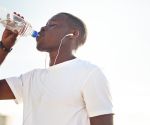The body has several different ways of providing energy during exercise. Dependent on the intensity and/or duration of activity – the body can provide energy through aerobic or anaerobic metabolism. The three energy systems under this umbrella are the ATP-PC System (immediate energy), the Glycolytic system (short term energy), and the Oxidative system (long term energy).
Each has a specific means of providing energy dependent on the body’s requirements.
Here's what happens when, for example, you start to run:
After about 3 seconds, the muscle cells burn off their supply of ATP. (Adenosine triphosphate, or ATP, is the way your body uses biochemicals to store and use energy.)
Then the phosphagen system kicks in. (ATP and creatine phosphate levels working together form the phosphagen system.) This supplies energy for 8 to 10 seconds. This system is the major energy system used by the muscles when rapid acceleration, short-duration exercise occurs, such as a 100-meter sprint.
Cells split glycogen into glucose and lactic acid, which produces enough ATP to last about 90 seconds of exercise. When exercise continues longer, then this glycogen-lactic acid system kicks in. Short-distance exercises, for example a 400-meter dash or 100-meter swim, will utilize this system.
Lastly, if exercise continues, then aerobic respiration takes over. Aerobic respiration uses carbohydrates, fats and proteins to make energy lasting as long as the fuel lasts. Such endurance events as a marathon run or cross-country skiing would utilize this system.
Continue Learning about Energy Boosters
Important: This content reflects information from various individuals and organizations and may offer alternative or opposing points of view. It should not be used for medical advice, diagnosis or treatment. As always, you should consult with your healthcare provider about your specific health needs.






